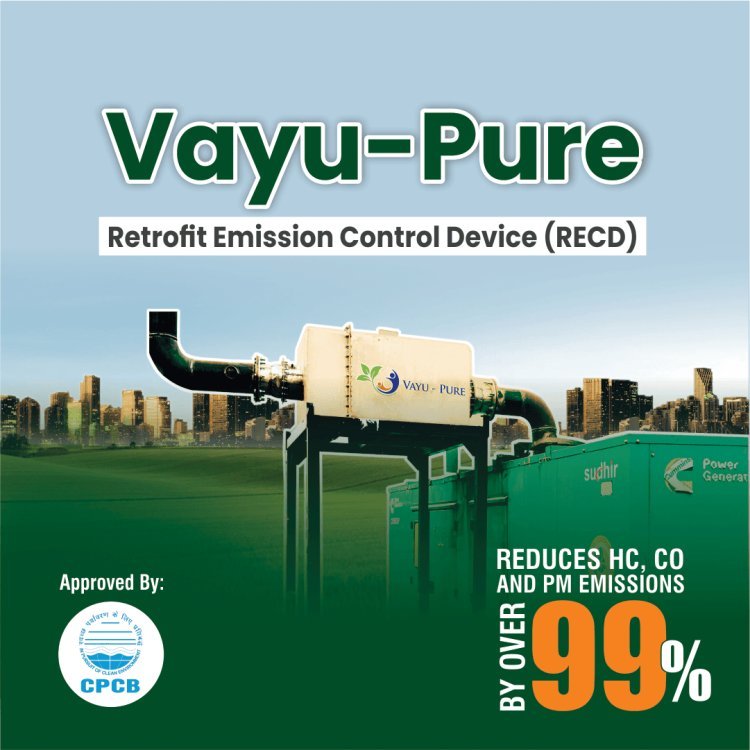Understanding Retrofit Emission Control Devices: A Solution for Cleaner Diesel Generators
Retrofit Emission Control Devices (RECDs) effectively reduce diesel generator emissions, ensuring environmental compliance and promoting sustainability.

Diesel generators are indispensable across various industries, providing reliable power solutions in sectors like manufacturing, construction, data centers, and healthcare facilities. However, their operation often comes at an environmental cost, emitting pollutants that degrade air quality and pose health risks. To address these concerns, Retrofit Emission Control Devices (RECDs) have emerged as a viable solution to mitigate harmful emissions from existing diesel generators.
What Are Retrofit Emission Control Devices?
Retrofit Emission Control Devices are advanced systems installed on existing diesel engines to reduce the emission of harmful pollutants such as particulate matter (PM), nitrogen oxides (NOx), carbon monoxide (CO), and hydrocarbons (HC). These devices upgrade older engines, enabling them to meet current emission standards without the need for complete replacement. Technologies employed in RECDs include:
- Diesel Particulate Filters (DPFs): Capture fine particulates from exhaust gases.
- Selective Catalytic Reduction (SCR): Use catalysts to convert NOx into harmless nitrogen and water.
- Oxidation Catalysts: Reduce hydrocarbon and carbon monoxide emissions.
- Electrostatic Precipitators: Capture particulates using electrical charges.
These technologies can be tailored to specific engine types and operational requirements, ensuring optimal performance and emission reduction.
How Do Retrofit Emission Control Devices Work?
The operation of an RECD varies based on the technology employed, but the general process involves:
- Exhaust Gas Collection: Engine exhaust gases enter the RECD system.
- Catalysis and Filtration: Gases pass through catalysts and filters that trap and neutralize harmful pollutants.
- Emission Reduction: Treated gases are released into the atmosphere with significantly reduced pollutant levels.
For instance, a Diesel Particulate Filter captures soot and particulates, preventing them from being emitted, while an SCR system injects a urea-based solution into the exhaust stream, converting NOx into nitrogen and water vapor.
Benefits of Implementing Retrofit Emission Control Devices
- Reduction of Air Pollutants: RECDs can decrease particulate matter and nitrogen oxide emissions by up to 90%, significantly improving air quality.
- Cost-Effectiveness: Upgrading existing equipment with RECDs is more economical than replacing entire generator systems, offering a practical solution for businesses.
- Regulatory Compliance: Installing RECDs ensures adherence to environmental regulations set by authorities such as the Central Pollution Control Board (CPCB) in India.
- Enhanced Engine Efficiency: Certain retrofit technologies can improve fuel efficiency and extend engine lifespan by reducing the buildup of harmful deposits.
- Corporate Sustainability: Adopting RECDs aligns with corporate social responsibility goals, showcasing a commitment to environmental stewardship.
Industries Benefiting from Retrofit Emission Control Devices
Several sectors rely on diesel generators and can significantly benefit from RECD implementation:
- Manufacturing Plants: Reduce emissions during production processes.
- Construction Industry: Control pollution from on-site power generation.
- Data Centers: Ensure backup power complies with emission standards.
- Healthcare Facilities: Maintain clean air quality with standby generators.
- Transportation and Logistics: Improve air quality by retrofitting diesel-powered fleets.
By integrating RECDs, these industries can operate more sustainably and meet stringent environmental regulations.
Selecting the Appropriate Retrofit Emission Control Device
When choosing an RECD, consider the following factors:
- Targeted Pollutants: Identify which emissions need reduction (e.g., NOx, PM, CO) to select the appropriate technology.
- Engine Compatibility: Ensure the device integrates seamlessly with existing engine systems.
- Efficiency and Durability: Opt for systems with proven high efficiency and longevity.
- Regulatory Compliance: Confirm that the device meets local and international emission standards.
Consulting with experts and reviewing verified technologies can aid in making an informed decision.
Future Outlook of Retrofit Emission Control Technologies
As global efforts to reduce carbon footprints intensify, RECD technologies are expected to evolve. Innovations may include advanced catalytic materials, AI-based monitoring systems, and hybrid filtration technologies, further enhancing efficiency and effectiveness. Investing in RECDs not only addresses current environmental concerns but also positions businesses to adapt to future regulatory changes and sustainability trends.
Conclusion
Inventive Gas Equipment's Retrofit Emission Control Devices (RECDs) provide a practical and effective solution for reducing harmful emissions from diesel generators. By implementing these advanced technologies, industries can achieve compliance with environmental regulations, enhance public health, and demonstrate a commitment to sustainability. Upgrading existing diesel engines with RECDs is a strategic move toward a cleaner and more responsible future.
What's Your Reaction?











